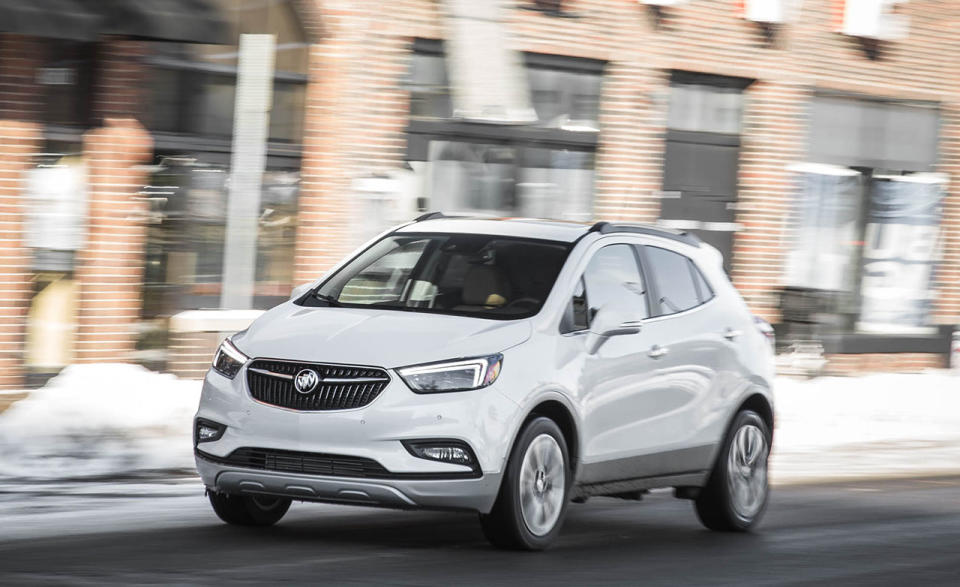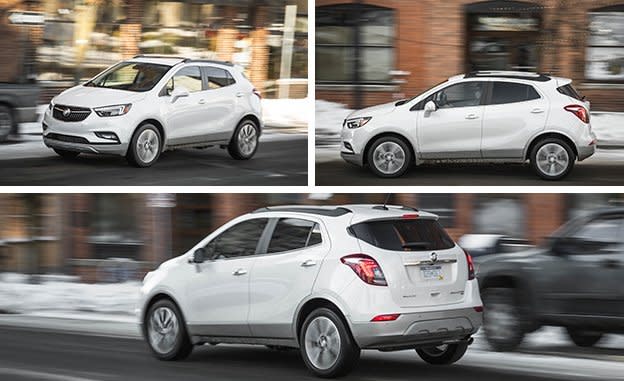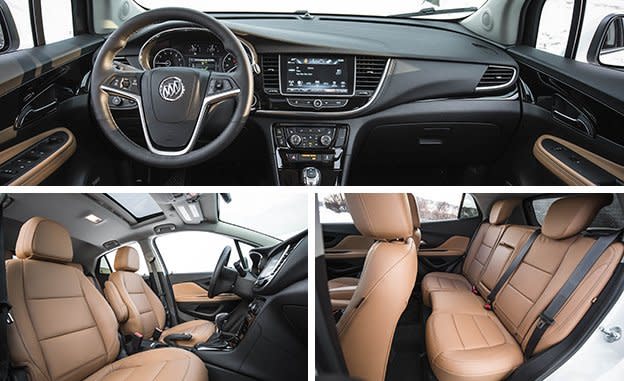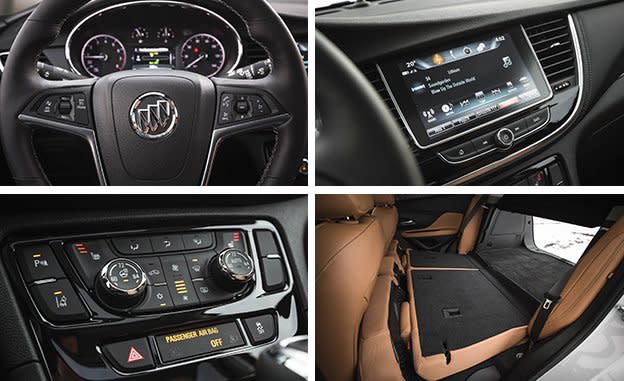2017 Buick Encore AWD

In the burgeoning field of subcompact crossovers, the Buick Encore stands out for a couple of important reasons.
For one, compared with its many competitors, it has an upscale aura, particularly inside. But whether we can refer to it as luxurious depends on your definition of that term. We think it’s not quite there, so we’ll settle on calling it premium, an industry word used to describe vehicles that aren’t quite classifiable as luxury but aren’t far from it.

Two, the Encore coddles occupants with a surprisingly supple ride given its short wheelbase as well as exceptionally low interior noise levels and upscale interior appointments, part of an overhaul for 2017 that also includes updated exterior sheetmetal. Those traits may not necessarily qualify the Encore as luxury, but they are subliminal elements in vehicles we regard as premium.
Turbo Fours Are Not Quite Twins
The Encore offers two engine choices, both 1.4-liter four-cylinders, both turbocharged, both long-stroke designs, yet one is standard and the other is an upgrade option. There are significant distinctions. For example, the base engine has a slightly smaller bore, a little less displacement (1364 cubic centimeters versus 1399), a lower compression ratio (9.5:1 versus 10.0:1), and port rather than direct fuel injection. The net result of these differences is a power disparity that may seem modest but in the realm of this small fry is significant: 138 horsepower and 148 lb-ft of torque for the base version, 153 hp and 177 lb-ft for the upgrade.
The higher-output engine is an $895 option on the Sport Touring trim level as well as—in ascending order—the Preferred II, Essence, and Premium. It can be had either with front- or all-wheel drive. It’s not available on the two lowest-priced versions, the base trim and the Preferred.

Note that even the upgrade engine is not the hottest powerplant in the segment. The Kia Soul Turbo (201 horsepower) and the Nissan Juke (188 ponies) have a lot more punch, and they get off the line with greater urgency. The Jeep Renegade offers a 180-hp 2.4-liter, but in rugged Trailhawk trim, it’s pudgy at nearly 3600 pounds and a tad lethargic.
But while the Encore—even with the higher-output engine—is not the quickest little pony in the subcompact corral, it’s not the slowest, either. In our recent test of a front-drive Sport Touring Encore, we recorded a zero-to-60-mph time of 7.8 seconds and a 16.2-second quarter-mile at 86 mph. We characterized those results as “peppy,” noting that it was the quickest Encore we’d tested.
Adding all-wheel drive, of course, adds mass. This all-wheel-drive Sport Touring weighed in at 3382 pounds versus 3244 for our front-drive example. (We photographed an Encore Premium.) And the inevitable consequence of greater mass is slower acceleration, in this case 8.4 seconds to 60 and 16.6 seconds through the quarter-mile at 83 mph. Those results don’t really constitute peppiness.

But they are better than the standard version of this engine achieved in an all-wheel-drive Encore. And they’re acceptable by the standards of the AWD models in this class.
Comfort-Oriented Dynamics
In any case, it’s clear that getting pinned against the seatback isn’t part of the appeal with these vehicles. But on other portions of the dynamic scorecard the all-wheel-drive Encore acquits itself pretty well. Brisk maneuvers bring an abundance of rock ’n’ roll, but the steering is reasonably quick (2.8 turns lock-to-lock) and more tactile than some. And the payoff for suspension tuning that favors compliance over roll stiffness is ride quality that’s benign even on washboard unpaved roads.
We weren’t able to document grip for this Encore due to snowy weather conditions, but expect it to be similar to the so-so 0.81 g recorded by the front-drive model. On the other hand, its 166-foot stopping distance from 70 mph is at the top of the class.

Fuel economy, though, is unremarkable—we logged 22 mpg—as is the performance of the six-speed automatic transmission. It includes a manual shifting function, operable by a thumb switch atop the shift lever, that is not at all tempting to employ. At least the engine’s auto stop-start function is one of the more seamless in the business, which is good, because, as in almost all Buicks, it can’t be switched off.
Consistent with its emphasis on comfort, the Encore is quiet, and, as we observed in our test of the front-drive version, its interior updates for 2017 create a more upscale aura than what’s found in the rank-and-file players in this arena.
The Encore’s pricing drives home its more-than-mainstream, not-quite-luxury status: A Sport Touring all-wheel-drive model like our test car starts at $26,790, right about where most of the volume-brand competition leaves off, although it remains several thousand dollars shy of starting figures for European rivals such as the Audi Q3 ($32,750), the BMW X1 ($34,095), and the Mercedes-Benz GLA-class ($33,775). The Encore was the Buick division’s best-seller in 2016, with 78,565 rolling out of U.S. dealer showrooms. Premium pricing, premium persona. The Encore seems to have a formula that works.
Specifications >
VEHICLE TYPE: front-engine, all-wheel-drive, 5-passenger, 4-door hatchback
PRICE AS TESTED: $31,220 (base price: $26,790)
ENGINE TYPE: turbocharged and intercooled DOHC 16-valve inline-4, aluminum block and head, direct fuel injection
Displacement: 85 cu in, 1399 cc
Power: 153 hp @ 5600 rpm
Torque: 177 lb-ft @ 2000 rpm
TRANSMISSION: 6-speed automatic with manual shifting mode
DIMENSIONS:
Wheelbase: 100.6 in
Length: 168.4 in
Width: 69.9 in Height: 65.2 in
Passenger volume: 93 cu ft
Cargo volume: 19 cu ft
Curb weight: 3382 lb
C/D TEST RESULTS:
Zero to 60 mph: 8.4 sec
Zero to 100 mph: 27.2 sec
Zero to 110 mph: 39.2 sec
Rolling start, 5–60 mph: 9.1 sec
Top gear, 30–50 mph: 4.8 sec
Top gear, 50–70 mph: 5.2 sec
Standing ¼-mile: 16.6 sec @ 83 mph
Top speed (drag limited): 120 mph
Braking, 70–0 mph: 166 ft
Roadholding, 300-ft-dia skidpad: not tested
FUEL ECONOMY:
EPA combined/city/highway driving: 28/26/31 mpg
C/D observed: 22 mpg

 Yahoo Autos
Yahoo Autos 